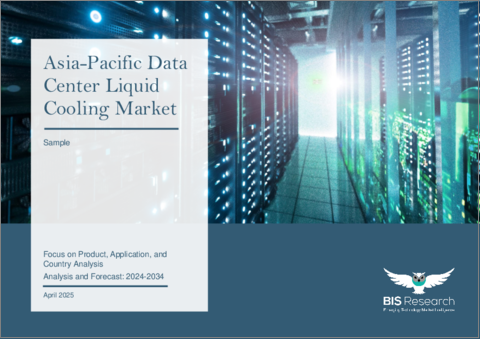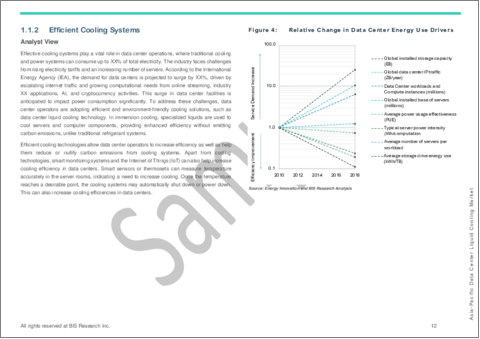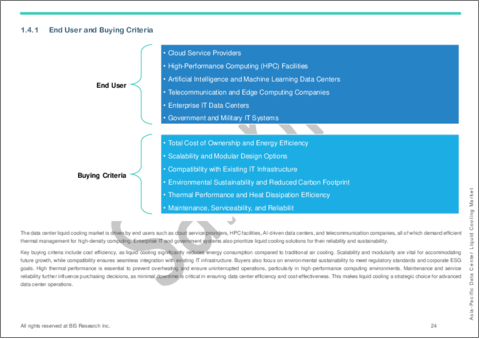|
|
市場調査レポート
商品コード
1707995
アジア太平洋のデータセンター向け液体冷却市場:製品別、用途別、国別 - 分析と予測(2024年~2034年)Asia-Pacific Data Center Liquid Cooling Market: Focus on Product, Application, and Country Analysis - Analysis and Forecast, 2024-2034 |
||||||
カスタマイズ可能
|
|||||||
| アジア太平洋のデータセンター向け液体冷却市場:製品別、用途別、国別 - 分析と予測(2024年~2034年) |
|
出版日: 2025年04月18日
発行: BIS Research
ページ情報: 英文 105 Pages
納期: 1~5営業日
|
全表示
- 概要
- 図表
- 目次
アジア太平洋のデータセンター向け液体冷却の市場規模(中国を除く)は、2024年に11億800万米ドルとなりました。
同市場は、2034年には117億6,590万米ドルに達すると予測され、予測期間の2024年~2034年のCAGRは26.65%と堅調な伸びを示すとみられています。アジア太平洋のデータセンター向け液体冷却市場は、高効率熱管理システムに対するニーズの高まりと新技術の迅速な導入により急速に拡大しています。従来の空冷技術は、クラウドコンピューティング、エッジコンピューティング、AIベースのワークロードの増加により、データセンターが小型化し、電力使用量が減少するにつれて、効果的ではなくなりつつあります。その結果、より優れた放熱性、より少ないエネルギー使用、空間効率の向上を実現する液体冷却が有力な選択肢となりつつあります。
この市場は、多くの重要な要因によって拡大しています。持続可能性の目標を達成し、運用コストを節約するためには、エネルギー効率が高く、省スペースな冷却技術が急務となっています。第二に、データセンター事業者は、高密度コンピューティング状況において、より高いオーバークロックを促進し、パフォーマンスを向上させる液体冷却の能力をより認識するようになっています。これは、ブロックチェーン、AI、機械学習など、高性能コンピューティング・インフラを必要とするアプリケーションにとって特に重要です。
| 主要市場統計 | |
|---|---|
| 予測期間 | 2024年~2034年 |
| 2024年の評価 | 11億800万米ドル |
| 2034年の予測 | 117億6,590万米ドル |
| CAGR | 26.65% |
さらに、都市密度と不動産コストに制約のあるアジア太平洋地域では、大幅な物理的拡張や高価なインフラの改修を必要とせずにコンピューティングパワーを向上させる液体冷却システムの能力が非常に魅力的です。液体冷却市場は、中国、インド、日本、シンガポールなどの国々がデジタルインフラやスマートテクノロジーへの投資を続けていることから、有利な規制枠組み、政府のインセンティブ、持続可能なデータセンター運営への注目の高まりから利益を得ることが期待されます。メーカーや技術サプライヤーは、このような状況の変化により、世界的に最も急成長しているデジタル分野の1つであるデータセンターで、自社製品を開発し、提供の幅を広げる絶好のチャンスを手にしています。
アジア太平洋地域では、スケーラブルで高性能、かつエネルギー効率の高いデータセンター・インフラに対するニーズが高まっており、同地域のデータセンター向け液体冷却市場を牽引しています。アジア太平洋のデータセンターは、クラウドコンピューティング、ビッグデータ、5G、人工知能の開発により業界全体でデジタルトランスフォーメーションが加速するにつれて、高密度化し、消費電力が増大しています。この変化が従来の空冷システムに多大な負担をかけているため、より効率的な熱処理方法として液体冷却技術への動向が高まっています。
ダイレクト・ツー・チップ冷却と液浸冷却は、エネルギー効率の向上、熱放散の拡大、設置面積の縮小など、いくつかの利点を持つ液体冷却技術の2つの例です。土地の制限や都市化により、コンパクトで持続可能なインフラが必要とされるアジア太平洋地域では、これらの技術は特に魅力的です。さらに、環境に対する関心の高まりや政府主導のグリーンデータ構想により、事業者は環境に優しい冷却ソリューションの利用を推奨されています。
ハイパースケールデータセンターに多額の投資を行い、持続可能な開発を支援する強固な政策を持っている中国、インド、日本、シンガポールなどの国々が開発をリードしています。高い初期設定コストと技術的ノウハウが障害となり続けているもの、継続的な技術革新、意識の高まり、テクノロジー・ベンダーとデータセンター・プロバイダー間の協力関係の改善により、導入は加速しています。このため、アジア太平洋液体冷却市場は長期的に力強い成長を遂げることが期待されています。
データセンターの高密度化と電力消費の増加に対応した効果的な冷却ソリューションへの需要の高まりが、アジア太平洋のデータセンター向け液体冷却市場の急拡大を後押ししています。クラウドコンピューティング、人工知能、5G、ビッグデータ分析の成長により、大量の熱を発生する高性能コンピューティングの必要性が高まっています。従来の空冷技術に比べ、直接チップ冷却や液浸冷却を含む液体冷却は、より優れた熱管理、エネルギー効率の向上、運用コストの削減を実現します。また、中国、インド、日本、シンガポールなどの国々では、カーボンフットプリントの削減や持続可能なインフラストラクチャーを支援する政府プログラムによって、採用が後押しされています。とはいえ、市場には先行価格の高さ、複雑な技術的詳細、液体冷却システムの導入と保守の経験不足といった障害が立ちはだかっています。さらに、既存の施設に液体冷却技術を導入するのは難しく、コストもかかります。このような障害にもかかわらず、技術革新の継続、環境上の利点に対する意識の高まり、政府の支援政策により、アジア太平洋全域で液体冷却技術の採用が進むと予想されます。
製品セグメントは、読者がアジア太平洋のデータセンター向け液体冷却のさまざまなアプリケーションと製品セグメント、およびアジア太平洋地域におけるそれらの可能性を理解するのに役立ちます。さらに、データセンターを含む様々な用途の液体冷却メーカーに影響を与える様々な規制、コンソーシアムや協会、政府プログラムを詳細に理解することができます。
アジア太平洋データセンター向け液体冷却市場では、事業拡大、提携、協業、合弁など、市場で事業を展開する主要企業による主要な開拓が見られます。アジア太平洋データセンター向け液体冷却市場では、各社がパートナーシップ、コラボレーション、ジョイントベンチャーを積極的に展開し、ポジションを強化しています。
アジア太平洋データセンター液体冷却市場でプロファイルされている企業は、一次専門家から収集した情報に基づいて選択されており、企業のカバレッジ、プロジェクトポートフォリオ、市場浸透度を分析しています。
当レポートでは、アジア太平洋のデータセンター向け液体冷却市場について調査し、市場の概要とともに、製品別、用途別、国別の動向、および市場に参入する企業のプロファイルなどを提供しています。
目次
エグゼクティブサマリー
第1章 市場:業界展望
- 動向:現状と将来への影響評価
- データセンターの液体冷却市場を形成する動向
- 効率的な冷却システム
- データセンター向け再生可能エネルギー
- エッジコンピューティングの需要の高まり
- 高性能ゲームとビットコインマイニングアプリケーションへの関心の高まり
- データ要件の増加
- データセンター冷却技術革新への投資急増
- データセンターの電力消費シナリオ
- その他の産業動向
- サプライチェーンの概要
- 研究開発レビュー
- 規制状況
- ステークホルダー分析
- ケーススタディ
- スタートアップの情勢
- 市場力学:概要
- データセンター用誘電液市場の展望
- PFAS禁止がデータセンターの液体冷却の見通しに与える影響
- 2018年~2023年における世界のデータセンター向け液体冷却導入の歴史的分析
- 2024年~2034年における液冷導入に向けたデータセンターの動向
- ラック密度の上昇がデータセンターの液体冷却に与える影響
第2章 地域
- 地域サマリー
- アジア太平洋
- 地域概要
- 市場成長促進要因
- 市場成長抑制要因
- 用途
- 製品
- 日本
- オーストラリア
- 韓国
- インド
- シンガポール
- その他
- 中国
第3章 競合ベンチマーキングと企業プロファイル
- 戦略的取り組み、2020年~2024年
- 市場シェア
- 戦略的イニシアチブのシェア、2020年~2024年
- 企業プロファイル
- PEZY Computing Inc.
- Firmus Technologies Pty Ltd
- Shenzhen MicroBT Electronics Technology Co., Ltd
- Sunonwealth Electric Machine Industry Co., Ltd.
- WERNER FINLEY
- FogHashing
第4章 調査手法
List of Figures
- Figure 1: Asia-Pacific Data Center Liquid Cooling Market (by End-Use Industry), $Million, 2023, 2027, and 2034
- Figure 2: Asia-Pacific Data Center Liquid Cooling Market (by Data Center), $Million, 2023, 2027, and 2034
- Figure 3: Asia-Pacific Data Center Liquid Cooling Market (by Solution), $Million, 2023, 2027, and 2034
- Figure 4: Relative Change in Data Center Energy Use Drivers
- Figure 5: Companies Using Renewable Sources of Energy, 2021
- Figure 6: Estimated Share of Worldwide 5G Adoption (Excluding IoT)
- Figure 7: Anticipated Energy Consumption (by Data Center), TWh, 2023
- Figure 8: Power Flows in a Typical Data Center
- Figure 9: Supply Chain and Risks within the Supply Chain
- Figure 10: Patent Filed (by Country), January 2021-December 2024
- Figure 11: Patent Filed (by Company), January 2021-December 2024
- Figure 12: Information Technology (IT) Spending on Data Centers, $Billion, 2012-2023
- Figure 13: Estimated World Population and Number of Smart Devices Using Internet, 2020-2025
- Figure 14: Historical Analysis: Estimated Number of Liquid Cooling Deployed Data Centers Globally, 2018-2023
- Figure 15: Future Market Analysis: Estimated Share of Liquid Cooling Deployment in Data Centers with AI Workload Impact, 2024-2034
- Figure 16: Average Data Center Rack Density (kW/Rack), 2013-2025
- Figure 17: Evolution of Rising Thermal Demands of Data Center Chips
- Figure 18: Japan Data Center Liquid Cooling Market, $Million, 2023-2034
- Figure 19: Australia Data Center Liquid Cooling Market, $Million, 2023-2034
- Figure 20: South Korea Data Center Liquid Cooling Market, $Million, 2023-2034
- Figure 21: India Data Center Liquid Cooling Market, $Million, 2023-2034
- Figure 22: Singapore Data Center Liquid Cooling Market, $Million, 2023-2034
- Figure 23: Rest-of-Asia-Pacific Data Center Liquid Cooling Market, $Million, 2023-2034
- Figure 24: Data Triangulation
- Figure 25: Top-Down and Bottom-Up Approach
- Figure 26: Assumptions and Limitations
List of Tables
- Table 1: Market Snapshot
- Table 2: Data Center Liquid Cooling Market, Opportunities across Regions
- Table 3: Recent Investments and Developments in Data Center Liquid Cooling Innovations
- Table 4: Impact Analysis of Market Navigating Factors, 2023-2034
- Table 5: Comprehensive Assessment of Different Types of Dielectric Fluids
- Table 6: Comparison between Dielectric Fluids based on Physical Parameters
- Table 7: Comparison of Rack Density in Conventional and AI Data Center Application
- Table 8: Cooling Technology Used by Data Center Thermal Capacity
- Table 9: Data Center Liquid Cooling Market (by Region), $Million, 2023-2034
- Table 10: Asia-Pacific Data Center Liquid Cooling Market (by End-Use Industry), $Million, 2023-2034
- Table 11: Asia-Pacific Data Center Liquid Cooling Market (by Data Center), $Million, 2023-2034
- Table 12: Asia-Pacific Data Center Liquid Cooling Market (by Solution), $Million, 2023-2034
- Table 13: Japan Data Center Liquid Cooling Market (by End-Use Industry), $Million, 2023-2034
- Table 14: Japan Data Center Liquid Cooling Market (by Data Center), $Million, 2023-2034
- Table 15: Japan Data Center Liquid Cooling Market (by Solution), $Million, 2023-2034
- Table 16: Australia Data Center Liquid Cooling Market (by End-Use Industry), $Million, 2023-2034
- Table 17: Australia Data Center Liquid Cooling Market (by Data Center), $Million, 2023-2034
- Table 18: Australia Data Center Liquid Cooling Market (by Solution), $Million, 2023-2034
- Table 19: South Korea Data Center Liquid Cooling Market (by End-Use Industry), $Million, 2023-2034
- Table 20: South Korea Data Center Liquid Cooling Market (by Data Center), $Million, 2023-2034
- Table 21: South Korea Data Center Liquid Cooling Market (by Solution), $Million, 2023-2034
- Table 22: India Data Center Liquid Cooling Market (by End-Use Industry), $Million, 2023-2034
- Table 23: India Data Center Liquid Cooling Market (by Data Center), $Million, 2023-2034
- Table 24: India Data Center Liquid Cooling Market (by Solution), $Million, 2023-2034
- Table 25: Singapore Data Center Liquid Cooling Market (by End-Use Industry), $Million, 2023-2034
- Table 26: Singapore Data Center Liquid Cooling Market (by Data Center), $Million, 2023-2034
- Table 27: Singapore Data Center Liquid Cooling Market (by Solution), $Million, 2023-2034
- Table 28: Rest-of-Asia-Pacific Data Center Liquid Cooling Market (by End-Use Industry), $Million, 2023-2034
- Table 29: Rest-of-Asia-Pacific Data Center Liquid Cooling Market (by Data Center), $Million, 2023-2034
- Table 30: Rest-of-Asia-Pacific Data Center Liquid Cooling Market (by Solution), $Million, 2023-2034
- Table 31: China Data Center Liquid Cooling Market (by End-Use Industry), $Million, 2023-2034
- Table 32: China Data Center Liquid Cooling Market (by Data Center), $Million, 2023-2034
- Table 33: China Data Center Liquid Cooling Market (by Solution), $Million, 2023-2034
Introduction to Asia-Pacific Data Center Liquid Cooling Market
The Asia-Pacific data center liquid cooling market (excluding China), valued at $1,108.0 million in 2024, is expected to reach $11,765.9 million by 2034, exhibiting a robust CAGR of 26.65% during the forecast period 2024-2034. The market for liquid cooling in data centres in Asia-Pacific is expanding rapidly due to the increasing need for high-efficiency thermal management systems and the quick adoption of new technologies. Traditional air cooling techniques are becoming less and less effective as data centres get smaller and use less electricity as a result of the growth of cloud computing, edge computing, and AI-based workloads. As a result, liquid cooling is becoming the go-to option since it provides better heat dissipation, less energy use, and increased spatial efficiency.
This market is expanding due to a number of important factors. In order to satisfy sustainability targets and save operating expenses, energy-efficient and space-saving cooling techniques are urgently needed. Second, data centre operators are becoming more aware of liquid cooling's capacity to facilitate higher overclocking and improve performance in high-density computing situations. This is particularly important for applications that need high-performance computing infrastructure, such as blockchain, AI, and machine learning.
| KEY MARKET STATISTICS | |
|---|---|
| Forecast Period | 2024 - 2034 |
| 2024 Evaluation | $1,108.0 Million |
| 2034 Forecast | $11,765.9 Million |
| CAGR | 26.65% |
Furthermore, in the APAC area, where urban density and real estate costs might be constraining, the capacity of liquid cooling systems to boost computing power without requiring significant physical expansions or expensive infrastructural overhauls is quite alluring. The market for liquid cooling is expected to gain from advantageous regulatory frameworks, government incentives, and a growing focus on sustainable data centre operations as nations like China, India, Japan, and Singapore continue to invest in digital infrastructure and smart technologies. Manufacturers and technology suppliers have a great chance to develop and broaden their product offerings in one of the fastest-growing digital sectors globally thanks to this changing landscape.
Market Introduction
The growing need for scalable, high-performance, and energy-efficient data centre infrastructure in the Asia-Pacific (APAC) region is propelling the market for liquid cooling for data centres in this region. Data centres in APAC are growing denser and more power-hungry as digital transformation speeds up across industries thanks to developments in cloud computing, big data, 5G, and artificial intelligence. Due to the tremendous strain this change has placed on conventional air cooling systems, there is a growing trend towards liquid cooling technologies as a more efficient way to handle heat.
Direct-to-chip and immersion cooling are two examples of liquid cooling techniques that have several advantages, including as increased energy efficiency, greater heat dissipation, and a smaller footprint. In the APAC area, where land limits and urbanisation necessitate compact and sustainable infrastructure, these technologies are especially alluring. Additionally, operators are being encouraged to use eco-friendly cooling solutions by growing environmental concerns and government-led green data initiatives.
Leading the way are nations like China, India, Japan, and Singapore, which have made significant investments in hyperscale data centres and have robust policies supporting sustainable development. Adoption is being accelerated by ongoing innovation, rising awareness, and improved cooperation between technology vendors and data centre providers, even though high initial setup costs and technical know-how continue to be obstacles. The APAC liquid cooling market is therefore well-positioned for strong long-term growth.
Market Segmentation
Segmentation 1: by End-Use
- IT and Telecom
- Banking, Financial Services, and Insurance (BFSI)
- Government and Public Sector
- Healthcare
- Manufacturing
- Retail
- Others
Segmentation 2: by Data Center
- Hyperscale Data Center
- Enterprise Data Center
- Colocation Data Center
- Others
Segmentation 3: by Solution
- Rear Door Heat Exchangers (RDHX)
- Direct Cooling
- Direct-to-Chip Liquid Cooling System
- Immersion Cooling System
Segmentation 4: by Region
- Asia-Pacific
- China
Market Trends, Drivers and Challenges of APAC Data Center Liquid Cooling Market
The growing demand for effective cooling solutions in response to rising data centre density and power consumption is propelling the APAC data centre liquid cooling market's rapid expansion. The need for high-performance computing, which produces a lot of heat, is being fuelled by the growth of cloud computing, artificial intelligence, 5G, and big data analytics. Compared to conventional air-cooling techniques, liquid cooling-including direct-to-chip and immersion cooling-offers better thermal management, increased energy efficiency, and reduced operating costs. Adoption is also being encouraged by government programs that support carbon footprint reduction and sustainable infrastructure in nations like China, India, Japan, and Singapore. Nevertheless, the market is confronted with obstacles like high upfront prices, intricate technical details, and a lack of experience in implementing and maintaining liquid cooling systems. Additionally, retrofitting existing facilities with liquid cooling technology can be difficult and costly. Despite these obstacles, continued innovation, increasing awareness of environmental benefits, and supportive government policies are expected to drive the adoption of liquid cooling technologies across APAC.
How can this report add value to an organization?
Product/Innovation Strategy: The product segment helps the reader understand the different application and product segments of APAC data center liquid cooling and their potential in APAC Region. Moreover, the study gives the reader a detailed understanding of the different regulations, consortiums and associations, and government programs impacting the liquid cooling manufacturers for various purposes, including data centers.
Growth/Marketing Strategy: The APAC data center liquid cooling market has seen major development by key players operating in the market, such as business expansion, partnership, collaboration, and joint venture. The favored strategy for the companies has been partnership, collaboration, and joint venture activities to strengthen their position in the APAC data center liquid cooling market.
Competitive Strategy: Key players in the APAC data center liquid cooling market analyzed and profiled in the study involve liquid cooling providers, including market segments covered by distinct product kinds, applications served, and regional presence, as well as the influence of important market tactics employed. Moreover, a detailed competitive benchmarking of the players operating in the APAC data center liquid cooling market has been done to help the reader understand how players stack against each other, presenting a clear market landscape. Additionally, comprehensive competitive strategies such as partnerships, agreements, and collaborations will aid the reader in understanding the untapped revenue pockets in the market.
Key Market Players and Competition Synopsis
The companies that are profiled in the APAC data center liquid cooling market have been selected based on input gathered from primary experts and analyzing company coverage, project portfolio, and market penetration.
Some of the prominent names in this market are:
- PEZY Computing Inc.
- Firmus Technologies Pty Ltd
- Shenzhen MicroBT Electronics Technology Co., Ltd
- Sunonwealth Electric Machine Industry Co., Ltd.
- WERNER FINLEY
- FogHashing
Table of Contents
Executive Summary
Scope and Definition
1 Market: Industry Outlook
- 1.1 Trends: Current and Future Impact Assessment
- 1.1.1 Trends Shaping Data Center Liquid Cooling Market
- 1.1.2 Efficient Cooling Systems
- 1.1.3 Renewable Energy for Data Centers
- 1.1.4 Rising Demand for Edge Computing
- 1.1.5 Increased Interest in High-Performance Gaming and Bitcoin Minning Applications
- 1.1.6 Increased Data Requirements
- 1.1.6.1 Increasing Rack Power Density - New Data Center Reality
- 1.1.6.2 5G Services to Drive Exponential Growth in Data Centers
- 1.1.7 Surge in Investments toward Data Center Cooling Innovations
- 1.1.8 Data Center Power Consumption Scenario
- 1.1.9 Other Industrial Trends
- 1.1.9.1 HPC Cluster Developments
- 1.1.9.2 Blockchain Initiatives
- 1.1.9.3 Super Computing
- 1.1.9.4 Impact of Server/Rack Density
- 1.2 Supply Chain Overview
- 1.3 Research and Development Review
- 1.3.1 Patent Filing Trend (by Country and Company)
- 1.4 Regulatory Landscape
- 1.4.1 Regulations
- 1.4.2 Guidelines/Standards
- 1.5 Stakeholder Analysis
- 1.5.1 End User and Buying Criteria
- 1.6 Case Study
- 1.6.1 Immersion Cooling Technology
- 1.6.1.1 HYDRA Immersion Cooling: Revolutionizing Data Centre Efficiency and Sustainability
- 1.6.1.2 Advancing Thermal Efficiency: The Role of Liquid Immersion Cooling in Future Data Centers
- 1.6.1.3 Transforming Data Centers: Enhanced Efficiency with GRC's CarnotJet System
- 1.6.1.4 Optimizing Immersion Phase-Change Cooling for Data Center Liquid Cooling Market
- 1.6.1.5 Revolutionizing Digital Payments with Liquid Cooling: A Sustainable Path to High-Performance Computing
- 1.6.1.6 Advancing Data Center Cooling Efficiency: KAORI and MIVOLT's Immersion Cooling Solution
- 1.6.1.7 Empowering Reliance Jio's Mobile Edge Compute with Immersion Cooling
- 1.6.1.8 Driving Efficiency and Sustainability with Liquid Immersion Cooling
- 1.6.1.9 Advancing Data Center Sustainability with Two-Phase Immersion Cooling
- 1.6.1 Immersion Cooling Technology
- 1.7 Startup Landscape
- 1.8 Market Dynamics: Overview
- 1.8.1 Market Drivers
- 1.8.1.1 Increasing Data Center Spending
- 1.8.1.2 Growing Need for Hyperscale Data Centers
- 1.8.1.3 Reduction in Operational Costs
- 1.8.2 Market Restraints
- 1.8.2.1 High Investment Costs
- 1.8.2.2 Alternative Technologies Existing in the Market
- 1.8.3 Market Opportunities
- 1.8.3.1 Retrofitting Opportunities
- 1.8.3.2 Heat Repurposing from Liquid-Cooled Data Centers
- 1.8.3.3 Growth in Penetration Rate of Internet and Cloud Services
- 1.8.1 Market Drivers
- 1.9 Data Center Dielectric Fluid Market Outlook
- 1.9.1 Selection Criteria for Dielectric Fluid for Data Center Immersion Cooling
- 1.9.2 Comparative Analysis for Different Liquid Cooling Technologies
- 1.9.3 Comparative Analysis for Dielectric Fluids
- 1.9.3.1 Rising Dielectric Fluid Usage Amid the Emergence of Liquid Cooling Trends
- 1.9.3.1.1 Comparison between Air and Liquid Cooling Technology
- 1.9.3.1.2 Green Innovation in Dielectric Fluids: Plant-Based Cooling Solutions for Data Centers and Crypto Mining Facilities
- 1.9.3.1 Rising Dielectric Fluid Usage Amid the Emergence of Liquid Cooling Trends
- 1.1 Impact of PFAS Ban on the Data Center Liquid Cooling Outlook
- 1.10.1 Advantages and Disadvantages of PFAS
- 1.11 Historical Analysis of Liquid Cooling Deployment across Data Centers, 2018-2023
- 1.12 New Data Center Trends toward Adoption of Liquid Cooling, 2024-2034
- 1.13 Impact of Rising Rack Density on Data Center Liquid Cooling
2 Regions
- 2.1 Regional Summary
- 2.2 Asia-Pacific
- 2.2.1 Regional Overview
- 2.2.2 Driving Factors for Market Growth
- 2.2.3 Factors Challenging the Market
- 2.2.4 Application
- 2.2.5 Product
- 2.2.6 Japan
- 2.2.6.1 Application
- 2.2.6.2 Product
- 2.2.7 Australia
- 2.2.7.1 Application
- 2.2.7.2 Product
- 2.2.8 South Korea
- 2.2.8.1 Application
- 2.2.8.2 Product
- 2.2.9 India
- 2.2.9.1 Application
- 2.2.9.2 Product
- 2.2.10 Singapore
- 2.2.10.1 Application
- 2.2.10.2 Product
- 2.2.11 Rest-of-Asia-Pacific
- 2.2.11.1 Application
- 2.2.11.2 Product
- 2.3 China
- 2.3.1 Regional Overview
- 2.3.2 Driving Factors for Market Growth
- 2.3.3 Factors Challenging the Market
- 2.3.4 Application
- 2.3.5 Product
3 Competitive Benchmarking & Company Profiles
- 3.1 Strategic Initiatives, 2020-2024
- 3.2 Market Share
- 3.2.1 Share of Strategic Initiatives, 2020-2024
- 3.3 Company Profiles
- 3.3.1 PEZY Computing Inc.
- 3.3.1.1 Overview
- 3.3.1.2 Top Products/Product Portfolio
- 3.3.1.3 Top Competitors
- 3.3.1.4 Target Customers
- 3.3.1.5 Key Personnel
- 3.3.1.6 Analyst View
- 3.3.1.7 Market Share
- 3.3.2 Firmus Technologies Pty Ltd
- 3.3.2.1 Overview
- 3.3.2.2 Top Products/Product Portfolio
- 3.3.2.3 Top Competitors
- 3.3.2.4 Target Customers
- 3.3.2.5 Key Personnel
- 3.3.2.6 Analyst View
- 3.3.3 Shenzhen MicroBT Electronics Technology Co., Ltd
- 3.3.3.1 Overview
- 3.3.3.2 Top Products/Product Portfolio
- 3.3.3.3 Top Competitors
- 3.3.3.4 Target Customers
- 3.3.3.5 Key Personnel
- 3.3.3.6 Analyst View
- 3.3.4 Sunonwealth Electric Machine Industry Co., Ltd.
- 3.3.4.1 Overview
- 3.3.4.2 Top Products/Product Portfolio
- 3.3.4.3 Top Competitors
- 3.3.4.4 Target Customers
- 3.3.4.5 Key Personnel
- 3.3.4.6 Analyst View
- 3.3.5 WERNER FINLEY
- 3.3.5.1 Overview
- 3.3.5.2 Top Products/Product Portfolio
- 3.3.5.3 Top Competitors
- 3.3.5.4 Target Customers
- 3.3.5.5 Key Personnel
- 3.3.5.6 Analyst View
- 3.3.6 FogHashing
- 3.3.6.1 Overview
- 3.3.6.2 Top Products/Product Portfolio
- 3.3.6.3 Top Competitors
- 3.3.6.4 Target Customers
- 3.3.6.5 Key Personnel
- 3.3.6.6 Analyst View
- 3.3.1 PEZY Computing Inc.
4 Research Methodology
- 4.1 Data Sources
- 4.1.1 Primary Data Sources
- 4.1.2 Secondary Data Sources
- 4.1.3 Data Triangulation
- 4.2 Market Estimation and Forecast





